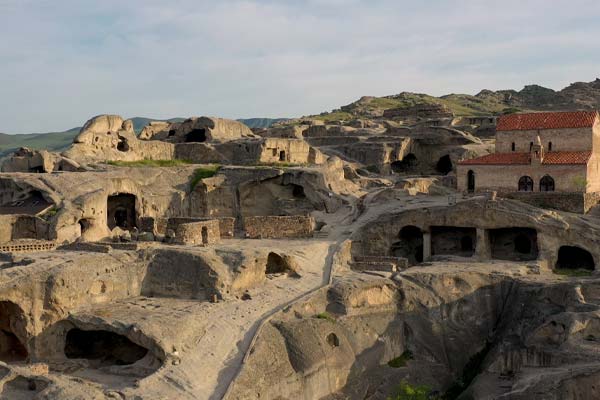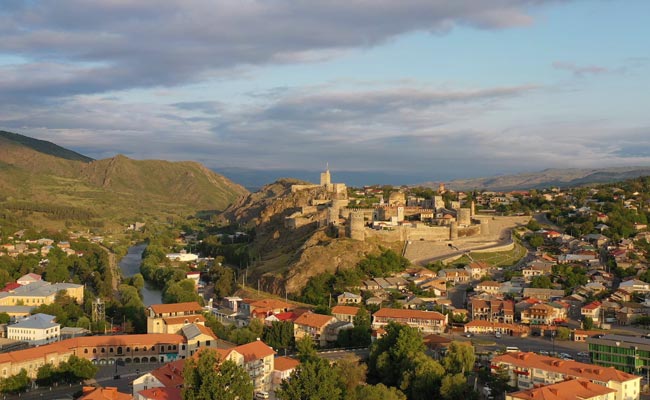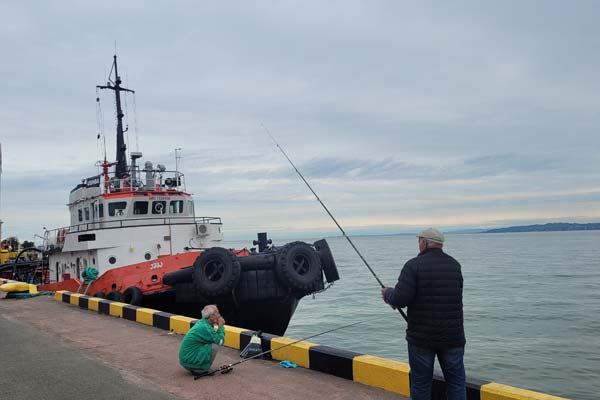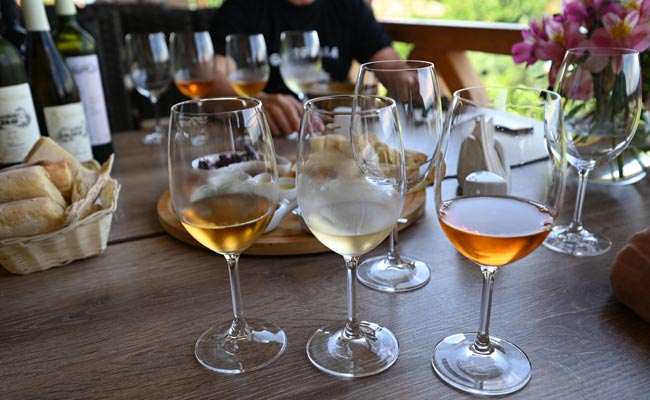|
Uplistsikhe - Georgia's oldest cave city Uplistsikhe is the oldest of Georgia's three cave cities, followed by David Gareja and Vardzia. It is also the only well-preserved complex of ancient buildings in Georgia. The first caves in Uplistsikhe were carved out of the rock as early as the 3rd millennium BC, and over time the settlement developed into a historically and culturally significant city. In its heyday, the city had well-developed roads, a water supply system, sewers, markets, an amphitheatre, palaces and a city wall. The name Uplis-Tsikhe literally means "Fortress of God" or "Fortress of the Lord". As Uplistsikhe existed well into pre-Christian times, it is thought that God or Lord referred to the powerful and influential tribal leader of the ethnic group that controlled Uplistsikhe and the surrounding areas at the time. Uplistsikhe from Sky You can visit our YouTube channel and enjoy 4K footage of Uplistsikhe History of Uplistsikhe As early as the 2nd millennium BC, the caves of Uplistsikhe were used by a powerful tribe as a place to live and hide. The tribe expanded the cave complex and over time came to control the surrounding settlements. By the 6th century BC, Uplistsikhe had become a politically, economically and culturally important centre of the region. For several decades, Uplistsikhe was also the seat of kings. It was also the religious centre for pre-Christian Georgians and pilgrims from other regions and neighbouring countries who came to Uplistsikhe to worship the idols. The city lost some of its importance when Christianity became the official state religion of Georgia in the 4th century. However, it remained a strongly fortified defence of the country and served as an important base for the Georgian kings against Arab invaders from the 8th century. During the internal conflicts of the 9th and 10th centuries, the fortress of Uplistsikhe changed hands several times. East Georgian princes from Kakheti fought here against the later kings of Georgia - the Bagrationis - and the reigning kings of Armenia to secure their rule over the region. After the unification of Georgia by the Bagrationis at the end of the 10th century, the development and defence of Uplistsikhe fell down the list of priorities of the Georgian crown. The Mongol invasions at the end of the 13th century finally led to the decline of the city and its military base. It is important to note that the Mongols were the first foreign invaders to conquer Uplistsikhe. In the 14th century the Georgian king Giorgi V rebuilt Uplistsikhe, but in the same century the Central Asian conqueror Temur Leng invaded Georgia several times and destroyed Uplistsikhe as well as the rest of the country. In the 15th century, after Central Asian and Ottoman invasions, Georgia was divided into several principalities and Uplistsikhe lost its function as a fortified city. From then on, the once magnificent city was only sporadically populated, serving as a refuge for the surrounding population in the event of raids. The last inhabitants left the cave city at the end of the 18th century. In 1920 there was a strong earthquake in the Uplistsikhe area which caused several caves to collapse. In the 20th century, the cave city was declared a museum. The cave town is still open to visitors and is now a listed monument. Uplistsikhe was inscribed on the UNESCO World Heritage List in 1993 and has been undergoing restoration since 2004, with funding from a World Bank and Georgian government heritage project. Architecture and building complex The cave city of Uplistsikhe covers an area of 9.5 hectares and was home to around 5,000 people. In ancient times there were 700 rooms, of which only 150 remain today. The cave city consists of 3 parts: the southern, northern and central parts. The southern part The people here lived in simple, small caves. They were mostly slaves who worked in the fields, carved more rooms into the rock or enlarged and renovated existing caves. They were also responsible for defending the city in the event of a siege. The northern part Simple people lived here, sometimes slaves or people sacrificed alive to the idols, whose main task was to serve the masters of the temples. They helped with religious rituals and looked after the temple houses. The central part This was where the wealthy lived. The priests, high priests and their families lived in large houses on the highest part of the complex, with good natural protection from the steep rock walls. The three parts of the city are separated by long and wide grooves cut into the rock. The shrines and idols of Uplistsikhe: Several gods were worshipped in Uplistsikhe. The most important of these were the God of the Earth, the God of the Underworld, the God of the Sun and the God of Water. Each idol had its own temple and was served by its own priests and a high priest. How was the city protected against invaders? The city had significant natural protection from the steep cliffs to the west and south, and from the Kura River to the south. To the north and east, an additional ten-metre high by 2.5-metre-wide rock wall was cut into the cliffs, which, together with the defensive walls and towers along its 150-metre length, completely shielded the city. The architecture The construction period and architecture of the cave city of Uplistsikhe can be roughly divided into two periods: the pre-Christian or ancient period and the post-Christian period. The pre-Christian architecture was very intricate and elaborate. Typical ornaments were carved into the stone, such as chapters, pilasters and coffered ceilings. Living rooms have only one floor and are not distributed over different floors. The post-Christian rooms are roughly worked. Traces of the tools used are clearly visible on the walls and the rooms are often built on top of each other in a floor system. As Uplistsikhe is carved out of sandstone, the stacked rooms have collapsed over time. The entrances to the city The city had two main entrances, a large one to the north and a smaller one to the south-west. There was also an entrance to the east. Pilgrims mainly entered the city from this side early in the morning at sunrise. At the eastern entrance there is a cave that was used as a prayer room with a pit for offering sacrifices. Another way into the city was through the secret tunnel from the river to the south. The tunnel, 3 metres in diameter and 50 metres long, was used to fetch water from the river or to leave the city secretly during sieges. Archaeological excavations and discoveries The Swiss Frédéric Dubois de Montpéreux carried out the first scientific exploration and description of the cave city of Uplistsikhe in 1830. Since then, several archaeological excavations have been carried out in the cave city, bringing to light artefacts dating from the 4th millennium BC to the 18th century AD. In addition to pottery and metal objects, glass of various colours has also been found. The finds from antiquity are mainly ceramic pots with various decorations and many agricultural tools. An important exhibit from the 2nd millennium is the figure of a goddess with obsidian eyes. Other important finds are the figure of a standing musician with a mask, the figure of a bull and other objects from the 7th century BC. The Hellenistic period (323-30 B.C.) has also yielded a large number of archaeological finds, mainly pottery, but very finely worked and often glazed, some with religious motifs. One of the most notable is a ceramic figure of a woman sitting on a rock: the figure was placed in a box covered with a cloth, and the cloth was decorated with 1,375 finely worked pieces of gold. The figure was called "Terracotta Goddess". Wine amphorae with Aramaic inscriptions, a writing stylus and many other artefacts were also found from the pre-Christian period. From the 1st century AD, several gold and silver objects such as coins, buttons, diadems, etc. have been found, as well as a lot of pottery and glass. Uplistsikhe and the Silk Road The Silk Road was not a single route, but there were several routes that were avoided or travelled along depending on the political and security situation. One of these routes ran from Persia to the Black Sea via Georgia. Uplistsikhe was on this route and owes its development as an economic centre of the country mainly to the Silk Road. This explains the large number of artefacts found in Uplistsikhe that come from countries far away from Georgia. Water supply in Uplistsikhe: There were three systems for supplying water to the city: 1. Ceramic pipes. There was a four-kilometre ceramic water pipeline from the nearby mountain - Kvernaki. There were water reservoirs in sections so that the water could collect and flow continuously. 2. Rainwater Rainwater was also stored in open rock reservoirs in the city. Some of these reservoirs can still be seen today. 3. The tunnel Another possibility was to get water from the Kura River, which was connected to the city by a secret tunnel. Legends about the origin of the cave city According to one version, Uplistsikhe has a biblical origin, in which "Uplos", a direct descendant of Noah, founded the city and gave it his own name. The genealogy of "Uplos" is as follows Noah - Jafet - Gomer (Targamos in Georgian) - Kartlos (founder of Georgia) - Mzchetos (founder of Mzcheta) and Uplos. Another legend says that all the excavation work for the city's caves was done by slaves. To motivate them, they were given chisels made of precious metal with an iron tip, with the promise that when the iron was worn out by the work, they would be given their freedom and the precious metal of their tool. Rooms that have been preserved and are easy to follow 1. Queen Tamara's room from the 2nd century Location of Uplistsikhe Uplistsikhe is located 12 kilometres east of the town of Gori, in region Shida Kartli, on the left bank of the Kura River. There is no direct public transport to the cave town, but you can get to Gori by bus or train and then take a taxi. Opening hours Every day, including Monday from 10 am to 7 pm. Price: 15 GEL
On following trip, you visit Uplistsikhe
from 1,690 EUR
|






